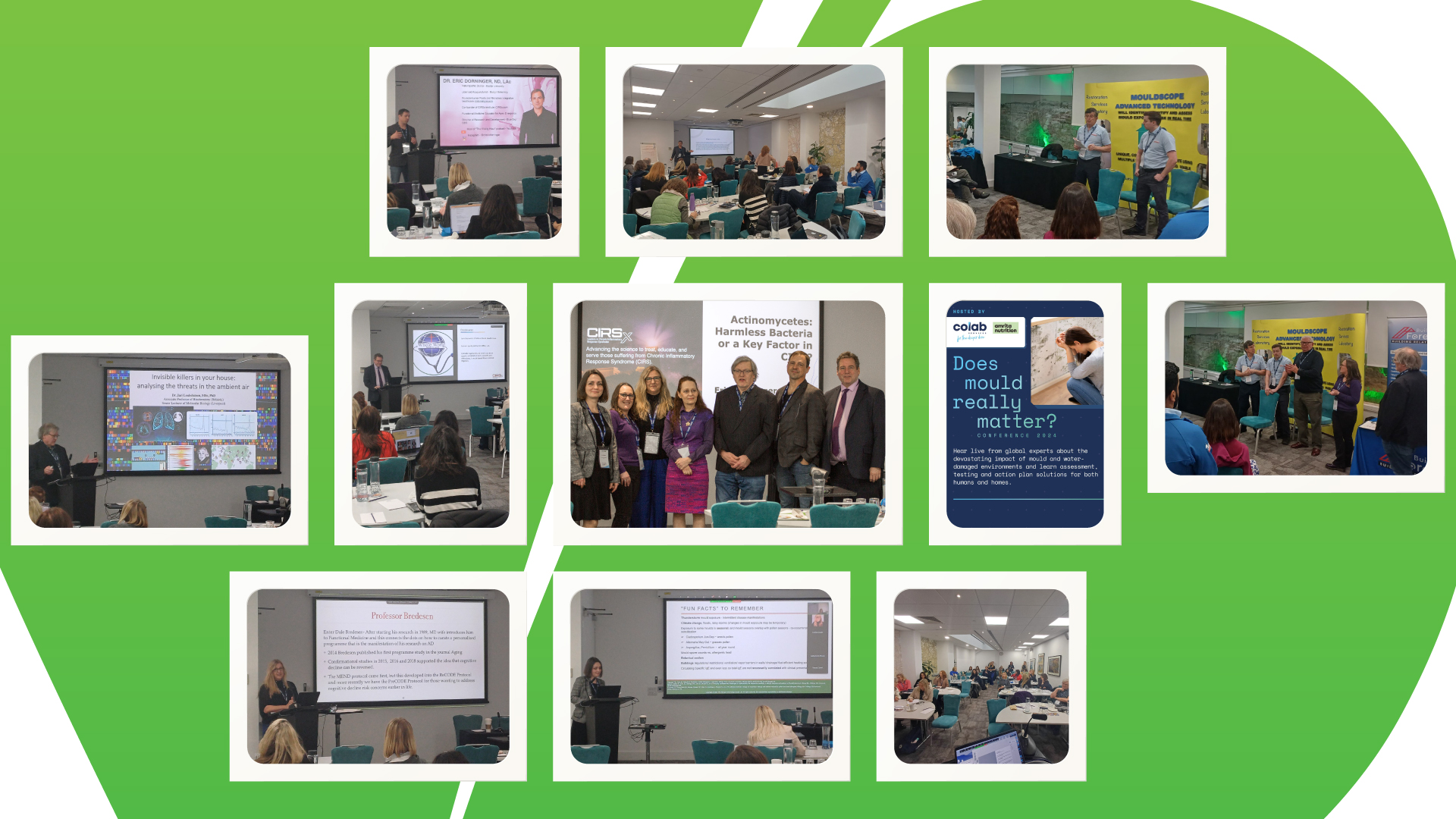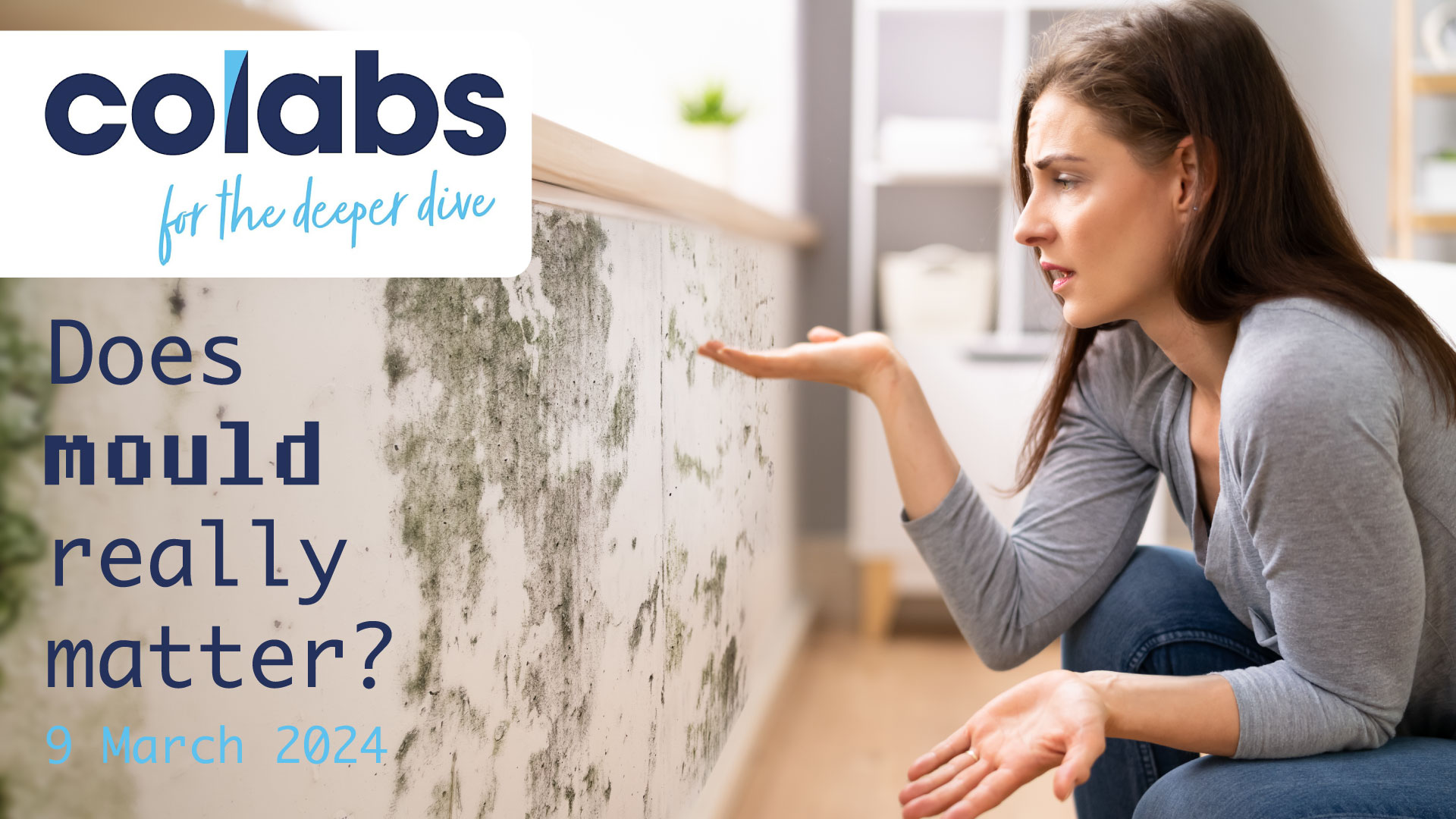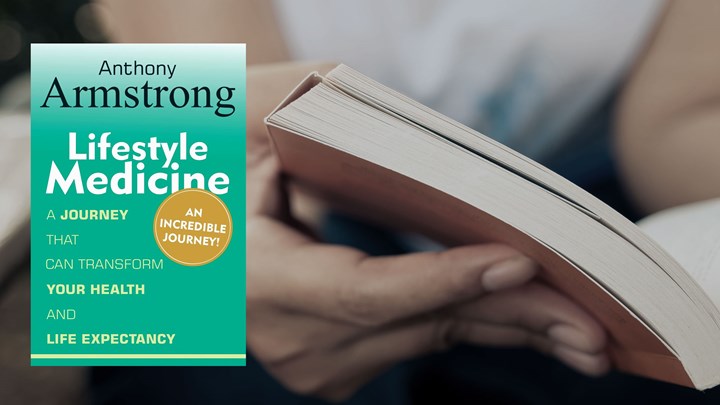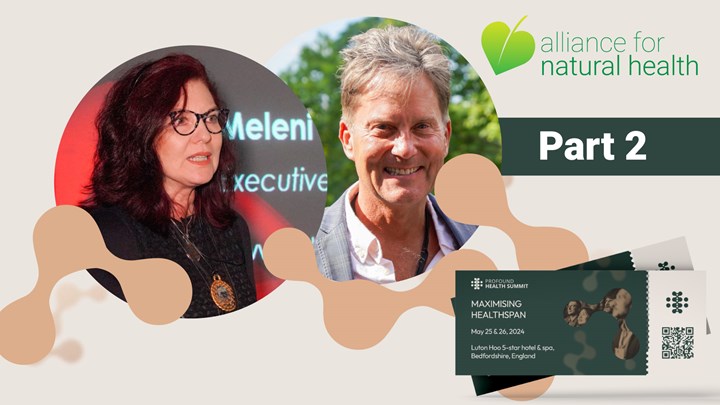Content Sections
By Meleni Aldridge, executive coordinator
Listen to the article
Read the article
According to Dr Scott McMahon, keynote speaker at the Does Mould Really Matter conference and veteran of the Shoemaker Method to surviving mould, it’s estimated that around 18 million people in the UK, and as many as 52 million in the US are both predisposed to mould illness — and exposed. However, the majority of these people don’t know it.
Melissa Smith and I were in attendance at the excellent conference put on by Louise Carder, co-founder and driving force behind Colab Services, a UK-based laboratory service for specialist, niche, functional testing, on Saturday 9th March in London. Louise is the first, and only, non-medical practitioner in Europe to be certified in the Shoemaker Protocol and has long been campaigning for more awareness and different treatment approaches for people suffering from Chronic Inflammatory Response Syndrome (CIRS), biotoxin illness (caused by moulds/molds and fungi) and the role of histamine in chronic illness, in particular.
>>> If you’re an ANH-Intl Health Professional Pathfinder and missed Louise Carder’s webinar diving deep into functional testing, you can watch it here for free, and non-members here for a small fee that helps keep our non-profit wheels turning.
Predisposed to moulds?
I’ve been a keen proponent of genetic testing for over a decade now because I understand the power of epigenetics (what you eat and the way you live your life) over your genes. Knowing which cards you’ve been dealt in your ‘book of life’ allows you to play a new epigenetic hand using nutrition and lifestyle modifications. I’m walking proof that it’s a potent and effective strategy, having regained my health after autoimmune thyroid disease and life-changing surgery. I wasn’t dealt the most health-giving hand and knowing my potential predispositions (many of which had become reality) from genes that can be modified by diet and lifestyle (what we call low-penetration genes) has been a game-changer for me.
So too might it be for people who have a particular genetic susceptibility through a set of gene variants on the Human Leukocyte Antigen (HLA) genes. HLA gene variants have now been shown to hold keys as to how your immune system might perceive and respond to the world around you and predispose your likelihood of developing certain conditions. Conditions such as gluten-sensitivity, coeliac disease and autoimmune conditions like rheumatoid arthritis, type 1 diabetes, Multiple Sclerosis and Systemic Lupus Erythematosus.
Two particular HLA gene variants — HLA-DRB1 and HLA-DQB1 — have been linked to an increased susceptibility to mould-related health issues and a heightened sensitivity to mould exposure and mycotoxins. Dr McMahon offered that as many as 25% of the population have these variants and could be pre-disposed to biotoxin illness if sufficiently exposed. Most of this population would have 1 copy of the susceptible genes (around 12%), and half again have 2 copies (double trouble!). So in numbers, that would be around 9 million people in the UK and more than 50 million in the US that are at risk of becoming not just affected, but seriously affected.
What does this actually mean? It means that these people who have these particular gene variants, and are then exposed to levels of mycotoxins that overwhelm their immune system's capability, are at higher risk of developing negative health impacts such as CIRS and histamine over-reaction, or Mast Cell Activation Syndrome.
Mycotoxins - risk and benefits
As with everything in Nature there are pluses and minuses when it comes to mycotoxins. Firstly, they’re here for a reason and we’ve evolved to live alongside them — albeit much more in an external environment.
It's important to recognise that fungi, including the subset that are moulds (or mold if you’re on the other side of the pond), play a key role in the functioning of all natural ecosystems. Especially for their role in breaking down complex organic matter and contributing to nutrient cycling, bioconversions and energy flows which are essential to all life on the planet — humans included.
The focus of the conference, and this article, are on effects linked to a small subset of fungal and mould toxins (mycotoxins or biotoxins) that under certain conditions, especially within indoor environments, at particular levels of exposure, among susceptible individuals, contribute to a diverse range of serious health problems, including hypersensitivity reactions.
In evolutionary biology terms, we’re not well adapted to indoor environments, particularly ones that are thermostatically controlled and sealed from draughts with double and triple glazing. When those hermetically sealed environments are then damp, loaded with mycotoxins and/or spores, and inhabited, or frequented as a workplace, by predisposed individuals, you have a recipe for inflammatory disaster.
>>> Understand more about how our genes and environment have played a role in our survival through evolution and why we’re now suffering so much in modern life.
Is your building better for moulds or you?
Many modern buildings made with modern materials are actually far worse for our health than the drafty old homes that our grandparents and great grandparents grew up in. Prof Jari Louhelainen, senior lecturer in Molecular Biology at Liverpool John Moores University and associate professor of Biochemistry at the University of Helsinki, Finland, enlightened us to the fact that indoor air can be up to 100 times more polluted than the air outside with as many as 900 chemicals at any time — all invisible to the eye.
When it comes to assessing the impact from spores or active moulds, there’s no difference to our immune system. A helpful analogy that was shared is to consider spores much like a bear hibernating that only take food and water to activate. Given their essential role in nature, spores are light and tiny so that they can freely flow on wind eddies. All good outside, but inside, in a sealed environment, the wind flow created by walking normally across a room is able to lift them to the height where they can readily be breathed into our respiratory systems. Think of spores as the sleeping/hibernating forms of moulds and fungi and mycotoxins as the by-products of active spores.
Prof Kirsi Vaali went on to discuss how modern building materials that include insulation, attic wool, paints, chemicals in flooring, carpets and furniture, concrete drying agents, glues and plastics actually help moulds to flourish. The biocidal chemicals that are then used to disinfect workplaces, schools and nurseries in this new pathogen-phobic world we live in, kill bacteria but help moulds to flourish. People often use such biocidal products to scrub off mould when they see it developing in their homes and then paint over the affected area, not realising that the disinfectant has done nothing to kill the spores or the mycotoxins and worse, the paint contains chemicals such as isothiazonolones, that will help the mould to not only grow back, but actively flourish.
Children are especially vulnerable given their lower height, particularly toddlers and babies, who might be crawling over the floor. Prof Vaali explained that the kind of inflammatory brainstorm that can ensue in babies and toddlers from inhaling spores and mycotoxins is often misinterpreted as food allergies. It’s a travesty that this information isn’t yet mainstream, as lots of nurseries are cleaning the floors with very toxic compounds that do nothing for moulds, creating a vicious cycle for these children’s health.
Dr Scott McMahon, being a paediatrician, spoke further about children in his keynote presentation. In the US, there around 10 million who experience chronic headaches and the same again with chronic stomach issues, but no apparent cause for either in terms of the usual pathologies. In Dr McMahon’s experience from his own practice, when he treats such children, 90% of them have between 4-6 biomarkers that indicate they’re suffering CIRS. He treats them with the Shoemaker Protocol and within as little as 2 weeks they’re seeing a significant improvement in symptoms.
 A collection of photographs from the Does Mould Really Matter Conference, March 9th, 2024, London.
A collection of photographs from the Does Mould Really Matter Conference, March 9th, 2024, London.
What might be the symptoms of mycotoxin/biotoxin illness?
At the start I mentioned CIRS — chronic inflammatory response syndrome — and the involvement of histamine. Please be aware that not everyone with CIRS has mould illness too, but mycotoxins are a significant contributor and a big issue for health professionals because, as yet, so many are so unaware of the impact mould in the home can have on health.
But what are the indications that you might be suffering from biotoxin exposure? Here is a list of symptoms from Dr Shoemaker’s website. As indicated, there are many mould symptoms, because the illness affects multiple systems in the body, which in turn, causes someone to exhibit multiple symptoms. If you are experiencing several of these symptoms, you could be suffering from mould illness and below is a link to take an inexpensive online screening test.
♦Fatigue ♦Weakness ♦Aches ♦Muscle Cramps ♦Unusual Pain ♦Ice Pick Pain ♦Headache ♦Light Sensitivity ♦Red Eyes ♦Blurred Vision ♦Tearing ♦Sinus Problems ♦Cough ♦Shortness of Breath ♦Abdominal Pain ♦Diarrhoea ♦Joint Pain ♦Morning Stiffness ♦Memory Issues ♦Focus/Concentration Issues ♦Word Recollection Issues ♦Decreased Learning of New Knowledge ♦Confusion ♦Disorientation ♦Skin Sensitivity ♦Mood Swings ♦Appetite Swings ♦Sweats (especially night sweats) ♦Temperature Regulation or Dysregulation Problems ♦Excessive Thirst ♦Increased Urination ♦Static Shocks ♦Numbness ♦Tingling ♦Vertigo ♦Metallic Taste ♦Tremors
>>> Take Dr Shoemaker’s online screening test for mould/biotoxin illness
Surviving mould
The solution, unfortunately, for those severely afflicted by biotoxin illness and suffering CIRS and other inflammatory complications, is full mould remediation. This is often a step too far for many as it entails not only getting specialist help in to clear the house/building, but also getting rid of clothes, towels, soft furnishings etc — anything that has existed in the mould-infested space. As challenging as it sounds, the experts at the conference all agree that it’s entirely necessary if you’re to recover your health and keep it that way.
>>> More here from Dr Shoemaker on remediation and surviving mould resources
Dr Eric Dorninger, a naturopathic doctor from Denver, Colarado, an experienced mould practitioner, shared not only his vast treatment experience, but also his own recent journey with mycotoxin illness after having covid. Dr Dorninger explained that spike protein from covid infection or covid jabs seem to be primers that are triggering CIRS and long-hauler syndrome in susceptible people. Where these people may have been living successfully with a number of biotoxins in their homes or places of work, the additional load from the spike protein is now priming them to descend into a form of secondary CIRS.
>>> More from Dr Eric Dorninger and surviving mould on his YouTube podcast: The Vitality Hour
It’s not within the scope of this article, to go further into the protocols that were shared on the day. If you’re a health professional interested in adding working with biotoxin illness to your list of skills, then I highly recommend you contact Colab Services directly for details on the conference recording.
If you’re an individual looking for support or feel that you may be suffering adverse effects from moulds and mycotoxins, please also contact Colab Services for practitioners in the UK and Europe, or if you’re in the US, find a practitioner via the Shoemaker portal.
Louise Carder will also be speaking at CIRSx on May 17th 2024, along with a host of other experts in this rapidly developing field.
>>> If you’re not already signed up for the ANH International weekly newsletter, sign up for free now using the SUBSCRIBE button at the top of our website – or better still – become a Pathfinder member and join the ANH-Intl tribe to enjoy benefits unique to our members.
>> Feel free to republish - just follow our Alliance for Natural Health International Re-publishing Guidelines








Comments
your voice counts
There are currently no comments on this post.
Your voice counts
We welcome your comments and are very interested in your point of view, but we ask that you keep them relevant to the article, that they be civil and without commercial links. All comments are moderated prior to being published. We reserve the right to edit or not publish comments that we consider abusive or offensive.
There is extra content here from a third party provider. You will be unable to see this content unless you agree to allow Content Cookies. Cookie Preferences